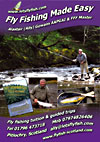Double haul and single haul fly casting
- increasing distance

| home | ask ally | fly casting | tuition | conservation | destinations | flies | articles | photos | links | contact me |
 |
Using hauling techniques - single and double haul.
Every combination of fly rod, line and angler has limits. Sometimes these limits are less than they might be because the angler has bad casting techniques. Often because they have never taken the trouble to learn the basics correctly. Becoming a good fly caster is like building a stairway, if your technique is good you can make safe and sure progress but if your workmanship is poor you can expect to fall at any time. If you want to make good hauls and to cast with little effort using the double haul your basic technique has to be sound, you have to be on a safe landing of that casting stairway and be able to make consistently good back and forward casts.
 |
| Double haul for efficiency |
When teaching hauling techniques I start with the back haul. Most anglers find that it is the easiest to learn. It does not depend on making a good cast beforehand because it is used to lift line from the water. Hauling only works correctly if it adds to the line speed that might be achieved without it. Therefore hauls should be concentrated and targeted to the final acceleration phase of the cast when the rod tip is traveling quickly. If you can make the haul during that period it will increase line speed and the stored energy in the rod to produce a longer cast. If the haul is made too early and completed before the final acceleration of the rod tip the cast may benefit because the line is taut during the lift but it is not going to increase the line speed to gain distance. If the haul is made too late, some benefit may be gained but the process is not as efficient as it might be. Ensuring that the fastest part of the haul coincides with the fastest rod tip speed gives maximum efficiency. The back haul reinforces the back cast and similarly the forward haul reinforces the forward cast. To make these hauls ensure that your hands are together at the start of the cast and accelerate your hands apart towards the end of the stroke, pulling the line smoothly and firmly with your non rod hand. Back hauling is useful for making a better back cast into a following wind and of course the front haul helps to cope with head winds. Single hauls are therefore a useful addition to the anglers casting armoury. Learning to make them correctly is also a great step towards good double hauling technique.
 |
| Double haul cartoon by Ally Gowans |
Describing the double haul is not terribly easy so I made this false casting double haul cartoon movie that demonstrates the the technique.
Double haul is the combination of both the back and forward single hauls. As previously described a single haul starts with your hands together and they move apart so a double haul starts with your hands together, they move apart during the back haul, move together again feeding line into the back cast as it is extending in the air and finally they move apart to accelerate the line during the forward cast before shooting line or feeding line into the forward cast as part of a false casting routine. In other words line is hauled during a back haul, the line is then fed into the back cast and hauled again on the forward cast. There are two common descriptions for the work of the non rod hand during this process. Together - apart, together - apart (common in UK) and down - up, down - shoot (American). Both are helpful reminders when learning the rhythm.
Hints for better hauling.
- Be smooth and ensure that both the rod hand and the line hand accelerate to a stop.
- The line hand must not complete before the rod tip speed is maximum.
- Rod tip speed is maximum just after the rod hand makes the stop.
- There should never be any slack line when feeding into the extending cast.
- Keep your fly line clean so that it shoots easily.
- It is better to haul a small amount of line at the correct time than to try to make long hauls when learning.
- Hauls must complement the action of the rod hand to increase rod loading and line speed.
| Copyright 2007 Alastair Gowans AAPGAI and FFF Master and THCI, APGAI. All rights reserved. |